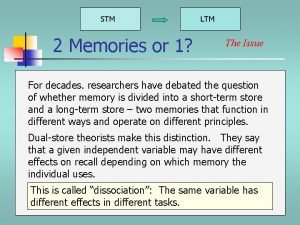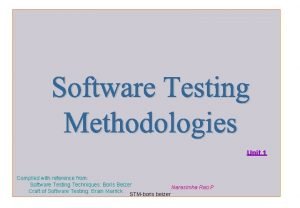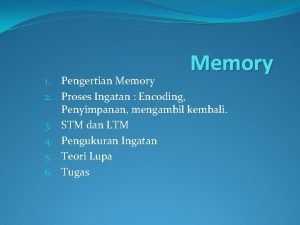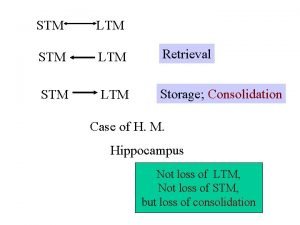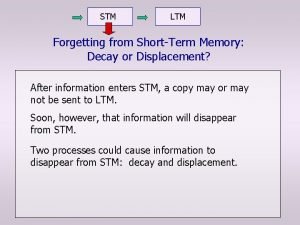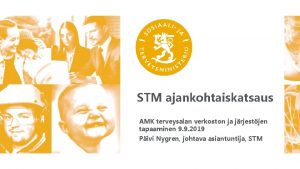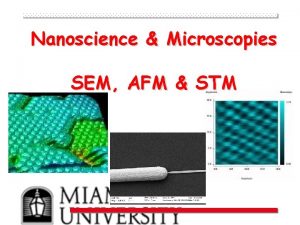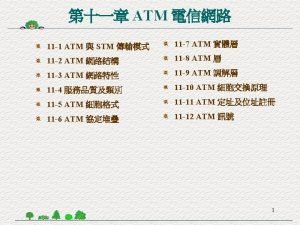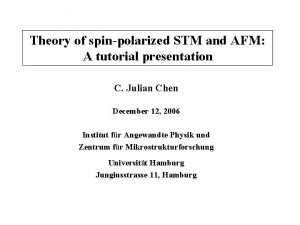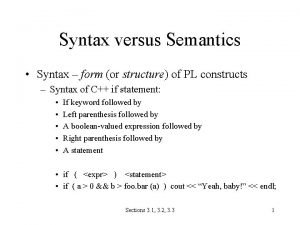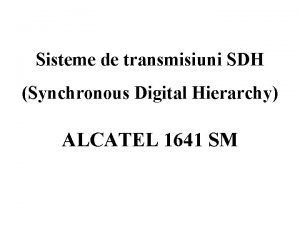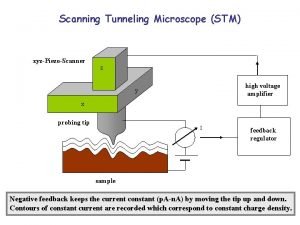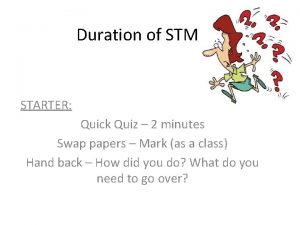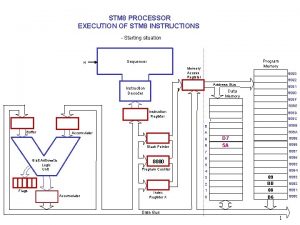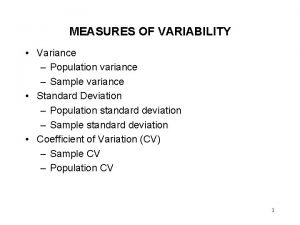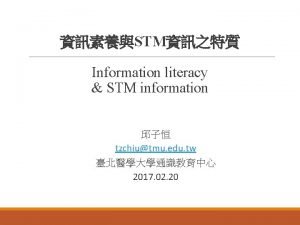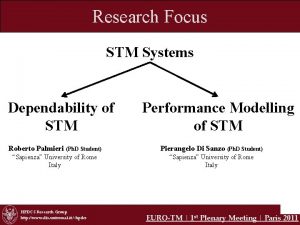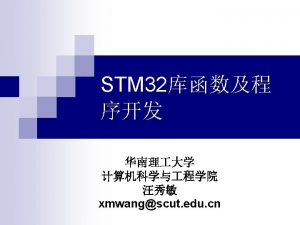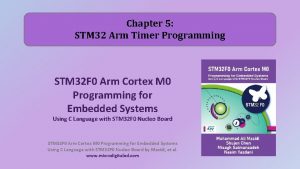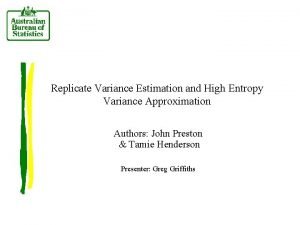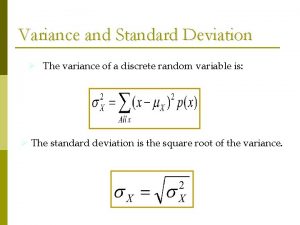Quantifying and Reducing Execution Variance in STM via





































- Slides: 37

Quantifying and Reducing Execution Variance in STM via Model Driven Commit Optimization Girish Mururu Ada Gavrilovska Santosh Pande


Computers can do the same thing over and over again emitting different results Are computers sane or Insane?

Are Computers Sane or Insane ? Computers are Non-deterministic regardless of being used to do sane or insane things

Non-determinism ➔ Variant behavior exhibited during repeated execution with same input ➔ Different sources ◆ Architecture, OS, runtime

Non-determinism ➔ Optimizing Non-determinism ◆ Debugging ◆ Robustness ◆ Repeatability

Execution Time Variance ➔ Execution time varies across runs due to nondeterminism ➔ In sequential programs, execution timings vary due to: ◆ co-executing programs ◆ context switches ◆ Architectural causes ● Branches, cache misses, TLB misses

Execution Time Variance in Parallel Programs ➔ Threads in parallel programs experience ◆ interference ◆ resource sharing ◆ scheduling decisions ➔ Parallel Programs experience more non-determinism and timing variance

Soft-real Time Apps ➔ Expect loose bound on timing variance ➔ For smooth user experience - bounds on ◆ Frame rates (lower) ◆ Jitters (higher ) ➔ Example - Games, Multimedia

Transactional Memory ➔ Soft real-time Apps can be developed using TMs ➔ A clean abstraction for parallel programming ◆ HTM, STM, Hybrid. TM ➔ Additional complexities with locks is avoided ◆ Deadlocks, livelocks, lock convoying, priority inversion ➔ Speculative execution increases variance

Software Transactional Memory (STM) ➔ A transaction is committed only after validation ➔ Invalid transactions are aborted and retried ➔ Aborts are unbounded ➔ Aborts add to non-determinism

Software Transactional Memory (STM) ➔ Unbounded non-determinism unlike lock based programs ➔ Non-determinism adds to variance in execution time ➔ 31% variance in frame rate processing in Syn-Quake, a STM version of Quake 3 game

Solution - approach ➔ Bounding the collective number of aborts of a given thread ◆ prioritizes a thread – loses speculation and fairness ➔ Prior work ◆ Irrevocable transactions - no rollbacks ● For handling I/O ● Deadline aware scheduling for STM ○ Meets deadline of certain transactions

Solution - approach ➔ A global solution to minimize the execution variances across all concurrent threads ➔ More complex than bounded aborts ◆ Context sensitive solution ● More context data -> performance degrades ● Less data -> does not work

Solution ➔ Model based on a probabilistic automaton ➔ Capture the state of concurrency of threads ➔ Determine the most common commit paths emanating from that state

Definitions ➔ Thread Transactional State (TSS) : tuple of thread IDs and transaction IDs of aborts and commits e. g. <a 1 b 2 c 3>, <d 4> ➔ Thread-State Automaton : a finite automaton of TSSs ➔ Transition Probability : TSA edge transition

State Model ➔ Stochastic automata ➔ Transition probability - frequency of a transition ➔ Transition function - input current state Excerpt from kmeans model

State Model <c 7>, <b 4> 5 0. 13 <a 2> <b 3> 0. 144 <a 0. 188 0. 144 <a 6>, <b 7> 0. 0 0 96 0. 02 <b 0> <a 1> 8 22 0. 1 <a 6>, <b 5> 0. 0 4> 48 0. 1 <a 5> <c 7>

Framework Training Input Profile Execution Transaction Sequence Model Generation Model Analysis Non-Optimizable Stop Model Test Input Guided Execution Less Variant Execution Out

Model Analysis ➔ Generate a metric over such possible transitions ➔ Traverse the possible transitions from each state ➔ Difference between guided and unguided execution

Model Analysis For each state Lower the better

Guided Execution ➔ Reduces the number of possible transitions before commit ➔ Reduces the number of new states formed during execution ➔ Holds back the thread with low transition probability

Experiments ➔ STAMP benchmark suite with TL 2 ➔ 8 core and 16 core intel machines ➔ Threshold transition = P/4, in which P = highest probability of a transition ➔ Dedicated core for each thread ➔ Bitwise storage of model within a state indexed hash-table

Execution Time Variance (8 threads)

Tail of Abort Distribution (8 threads)

Execution Time Variance (16 threads)

Tail of Abort Distribution (16 threads)

Reduction in Non-determinism

Timing Performance

Syn. Quake - STM version of Quake 3 ➔ Syn. Quake: a 2 D version of the real world Quake 3 multiplayer game ➔ Syn. Quake employs a fine grained consistency at object level ➔ Syn. Quake is faster than lock-based version of the game and is also scalable

Lib. TM in Syn. Quake ➔ Lib. TM: an object based STM ◆ 4 conflict detection mechanisms (Fully Pessimistic to Fully optimistic) ◆ 2 conflict resolution mechanisms ( wait-for-readers, abort readers) ➔ Syn. Quake uses fully optimistic conflict detection and abortreaders conflict resolution mechanisms

Syn. Quake Inputs ➔ Quests are specific areas in the map that attracts players thus simulating: ◆ A high interest area in the game play ◆ Associated different player movement pattern

Syn. Quake Experiments ➔ Experiments were conducted with 1000 players ◆ Training input 4 worst_case. quest and 4 moving. quest ◆ Testing input 4 quadrants. quest and 4 center_spread 6. quest ➔ The training set was selected to have a representative behavior

Syn. Quake Results

Syn. Quake Execution Time ➔ 8 threads ◆ Speedup of 35% for 4 Quadrants. quest ◆ Speedup of 10% for 4 center_spread 6. quest ➔ 16 threads ◆ Slowdown of 1% for 4 Quadrants. quest ◆ Speedup of 3% for 4 center_spread 6. quest ➔ Object based STM - no spurious conflicts ➔ Training input captures behavior

Summary ➔ Minimizing execution variance is required as STM gets adopted ➔ GSTM - utility of the model is checked for optimization ➔ Reduction in variance in STAMPS ◆ Up to 74% in 16 cores ◆ Up to 53% in 8 cores ➔ Max slowdown of 1. 6 x ➔ Reduction in variance frame rate processing in Syn. Quake without slowdown

Thank You
 Glycogen metabolism
Glycogen metabolism Molisch test reaction
Molisch test reaction Reducing and non reducing sugar
Reducing and non reducing sugar Twitter
Twitter Quantify noun
Quantify noun Dr martin goldberg
Dr martin goldberg Quantifying location privacy
Quantifying location privacy When quantifying country risk:
When quantifying country risk: Standard costing and variance analysis formulas
Standard costing and variance analysis formulas Reducing vs non reducing sugars
Reducing vs non reducing sugars Via negativa
Via negativa Decimo quinta estacion via crucis
Decimo quinta estacion via crucis Imágenes de las 14 estaciones del vía lucis
Imágenes de las 14 estaciones del vía lucis Haz piramidal directo
Haz piramidal directo Palavras convergentes
Palavras convergentes Stm ltm
Stm ltm Taxonomy of bugs in stm
Taxonomy of bugs in stm Navsea 05 tech warrant holders
Navsea 05 tech warrant holders Modis hq
Modis hq Perbedaan stm dan ltm
Perbedaan stm dan ltm The learning hypothesis
The learning hypothesis Stm ltm
Stm ltm Stm brighton launch
Stm brighton launch Stm 32f7
Stm 32f7 Contoh pendekatan inkuiri dalam pembelajaran ipa sd
Contoh pendekatan inkuiri dalam pembelajaran ipa sd Stm arm
Stm arm Päivi nygren stm
Päivi nygren stm Sem block diagram
Sem block diagram Stm erp
Stm erp Synchronous transfer mode
Synchronous transfer mode Stm tutorial
Stm tutorial Semantics vs syntax
Semantics vs syntax Stm
Stm Pdh sdh
Pdh sdh Stm
Stm Duration of stm
Duration of stm Gpiox_moder
Gpiox_moder Stm mikrokontroler
Stm mikrokontroler















